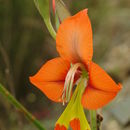Biology
provided by Arkive
The turkey-chick produces flowers from August until September (2), soon after the main rainy period when plant growth is optimal (5). The flowers produce a weak, slightly acrid odour (5), which attracts bees, particularly the species Anthophora diversipes and Rediviva aurata (7). As a bee drinks the flower's rich nectar from a tube at the back of the flower, pollen rubs on to the bee. At the next flower the bee feeds from, pollen grains will be deposited, and thus pollination occurs (5) (7).
Conservation
provided by Arkive
Within the Cape Floristic Region, there are a number of protected areas and a number of conservation organisations are working to conserve this botanically rich habitat (10). Conservation actions include purchasing land to protect it from the threats of encroaching agriculture and urban development (11), the removal of alien plants, and the establishment of new protected areas (8); measures which should benefit the endangered variety of this beautifully unusual flower.
Description
provided by Arkive
The peculiarly named turkey-chick is a geophyte (2); a plant that can survive periods of unfavourable conditions due to an underground food-storage organ (4). The turkey-chick has sickle-shaped, ribbed leaves and dazzling, delicate flowers (2), adapted for bee pollination (5). The flowers have a two-lipped structure, with a straight upper petal, and are bright orange with conspicuous yellowish-green patches on the lower petals (6).
Habitat
provided by Arkive
The turkey-chick grows on flats, slopes and plateaus, mainly in sand (2).
Range
provided by Arkive
Endemic to the Cape Floristic Region, an area in south-western South Africa which is home to the highest density of plant species in the world. The turkey-chick is distributed from the Bokkeveld Mountains, south to Bredasdorp (2).
Status
provided by Arkive
Variety Gladiolus alatus var. algoensis is classified as Endangered on the Red Data List of Southern African Plants (3).
Threats
provided by Arkive
The variety Gladiolus alatus var. algoensis is classified as Endangered but there is no information available indicating what specific threats this plant may face. However, as it is endemic to the Cape Floristic Region, it is likely to be affected by a number of threats which are impacting the natural habitat of this botanically unique area. These threats include urban development, the encroachment of agriculture, and the invasion of alien plant species (8) (9).
Gladiolus alatus
provided by wikipedia EN
Gladiolus alatus is a species of Gladiolus found from southern Namaqualand south to the Cape Peninsula and east to Caledon and Bredasdorp, South Africa. It is found growing on slopes with sandstone and granitic soils.[2]
Description
The flowers bloom from August to October and are sweetly scented.

Gladiolus alatus in South African habitat
References

- license
- cc-by-sa-3.0
- copyright
- Wikipedia authors and editors
Gladiolus alatus: Brief Summary
provided by wikipedia EN
Gladiolus alatus is a species of Gladiolus found from southern Namaqualand south to the Cape Peninsula and east to Caledon and Bredasdorp, South Africa. It is found growing on slopes with sandstone and granitic soils.
- license
- cc-by-sa-3.0
- copyright
- Wikipedia authors and editors

